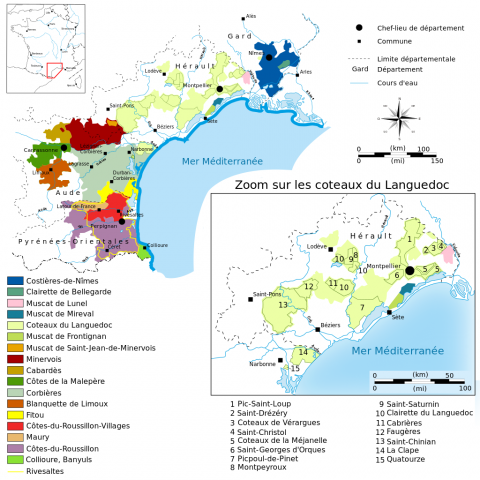Breadcrumb
- Home /
Key Datas:
- Location: On the border of the Mediterranean sea, from the Rhône river to the Pyrénées mountains and Spain
- Size of the vineyards: 160,000 hectares (400,000 acres), including 70,000 hectares (173,000 acres) in AOC
- Vineyards: 50,000 vine growers working with 400 co-ops (70% of the regional production), 2,800 private wineries
- Soil: Mainly limestone, sandstone, pebbles, granite can also be found
- Weather: Mediterranean(mild winter and hot summer)
- Red Grapes in Languedoc Roussillon: Carignan, Grenache, Syrah, Cinsault, Merlot, Cabernet Sauvignon, Mourvèdre
- White Grapes in Languedoc Roussillon: Clairette, Roussane, Marsanne, Ugni Blanc, Bourboulenc, Viognier, Chardonnay
- Production: Over 2 billion bottles less than 25% in AOC, 50% vin de pays, over 25% vin de table
- Type of Wine: Dry and fruity rosé wine also dry white wine - red wine - sweet wine
Languedoc-Rousillon covers the area on the border of the Mediterranean sea between the west of the Rhône and Camargue to the border of Spain and the Pyrénées mountains.
The vineyards of this sunny region are one of the largest expanses of vine growing region in the world.Long history of wine making and favorable natural and climatic conditions explain why wine is so important in Languedoc Roussillon. Dramatic have been made other the years to reduce the production and to improve the quality of the wine.
Languedoc-Roussillon region produces mainly red wines, a good share is "Vin de Table" but most of it is "Vin de Pays". They are perfect as every day wines. AOC wines are very interesting to follow as the techniques, grape varieties and vineyards selected tend to improve the quality of the wine.
Languedoc-Rousillon is the largest vine growing area in the world. From the Rhône to Spain, the wine region is several times bigger than the Australian wine region or Bordeaux.
The main grapes used in Languedoc Roussillon are:
- Red: Carignan, Cinsault, Grenache, Syrah, Mourvèdre. Cabernet Sauvignon and Merlot have replaced other mediocre grape varieties such as Aramon and Alicante.
- White: Macabeu, Clairette, Roussanne, Marsanne, Ugni blanc, Bourboulenc. Viognier and Chardonnay have been introduced with success in Languedoc Roussillon. Chardonnay is now the most widely used grape in the region.
- Sweet white wine: Muscat blanc, Muscat romain or d'Alexandrie and Grenache
At the beginning of the 70s, it became clear that the region was not ready for the changing wine market. The quantity exceeded the demand. The quality was mediocre. The price too expensive compare to Italian, Spain and now new wine countries. Languedoc Roussillon wine makers had to change or their wine region would die. They began to use new techniques such as aging the wine in oak barrel. They replaced poor quality grape varieties with noble grapes such as Cabernet Sauvignon and Merlot, Chardonnay and Viognier. They selected the best vineyards and decided to go for quality. Today, Languedoc Roussillon is one of the most successful wine regions in France.
Contact Us
Copyright © 2022. All rights reserved.
